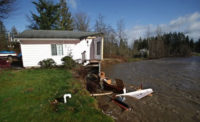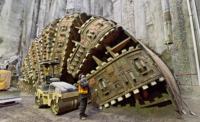
New unstable-slope rules, updated in 2011 by the Washington State Dept. of Natural Resources, and unheeded warnings about logging as far back as 1988, could not prevent the March 22 landslide near Oso nor keep victims out of its deadly path.
The event has killed at least 24, with 22 missing, as of April 1.
David Montgomery, University of Washington geomorphologist, says that the Oso event in the Hazel Slide area was a reactivation of past several events and prone to slide again. “When a slope fails, you create a plane of weakness in the soil and it keeps failing,” he says. “It was a really wet and not very strong slope.”
The 2006 slide followed a history of logging that had left the area void of large-rooted trees. “The slope has a complex history of vegetation,” Montgomery says. “If you take the big trees off they do not suck as much water off the ground.”
When you toss in 200% more rainfall in 2014 than an average year, including a soaking March that equates to roughly an additional 15 in. of rain, there was simply too much water mixing with “very weak glacial sediments” to allow the hill to hold.
Dave Norman, Washington Dept. of Natural Resources geologist, says the slide stretches about 4,300 ft wide and as much as 40 ft deep to include as up to 7 million cu yds of sand, silt and clay.
The department regulates forest practices on non-federal forestland, including timber harvest, road building and other activities.
Landslide risk and unstable slopes are among protections addressed by the agency’s rules, which were updated in 2011 to protect the areas near unstable slopes by replacing generalized prescription protections with site-specific requirements.
With a history of timber harvesting in the area—including a 7-acre clear cut above the slide—dating back to the 1800s, the most recent by a private forest landowner in 2005 and 2011, there were decades of less stringent rules.
Along with ancient slides, the Hazel area slid in 1967, 1988 and 2006.
Paul Kennard, a geologist now working for National Park Service but formerly with the Tulalip Tribe, has spoken publicly since the slide about his logging concerns, dating back to 1988.
“This had been known at least since the ‘50s as one of the more problematic areas on the Stillaguamish [River] for perennial land sliding,” he says. “It was our contention [in 1988] that harvest in the area just above the slide would increase the amount of groundwater, and essentially the largest factor in causing the slide was an increase in groundwater.”
A department-issued stop-work order on Summit Timber in 1988 was the first response to these groundwater concerns. Summit did harvest throughout the ‘80s, but the agency started restricting the areas in which the firm could work.
Grandy Lake Forest Associates and the department now own the land above the slide. Grandy Lake cut adjacent to the slide zone in 2005, 2009 and 2011, even while a more invasive application was rejected in 2004.
“The restrictions on timber harvest in this area were designed to prevent forest practices from contributing to increased landslide risks,” says state forester Aaron Everett.






